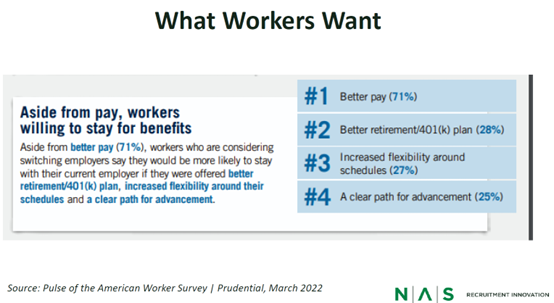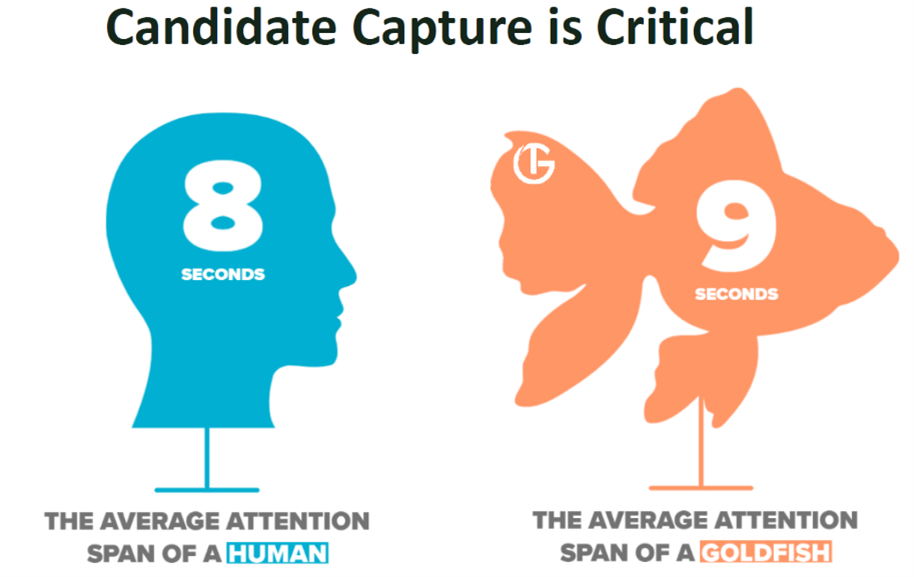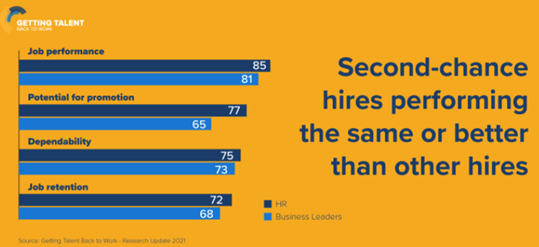-
Modernize your recruiting by designing strategies that match your priorities
Posted by Jennifer R. Henley, PHR & SHRM-CP | Chief Customer Officer on August 15th, 2022 
If someone were to look through your desk drawers or the saved documents folder on your desktop, it is likely they might stumble upon a letter of resignation that you just haven’t sent yet. In fact, over half of employed Americans have that letter tucked away and are just waiting for the straw that will break the camel’s back.What does this mean for recruiters?
- First, it means we are in one of the most competitive times in recruiting. According to the S. Bureau of Labor Statistics (June 2022), 372,000 jobs were added to the job boards. On top of that, the U.S. is facing its lowest unemployment rate since December of 1969 with a striking 3.6 percent.
- Second, it means recruiters must be perfectly in tune with the wants of the job seeker. In March, Prudential published the Pulse of the American Worker Survey (2022), which stated the top 4 wants of job seekers. At the top, 71% stated better pay as their motivating factor to remain with their current employer instead of seeking out other employment. Aside from better pay, respondents said they would stay for better benefits, increased schedule flexibility and clear advancement opportunities.
- Third, it means considering the location of the jobs you’re posting. Since January of 2020, there has been a steep increase in the search for remote jobs. In April of 2022, remote jobs posted on Indeed reached 9.5%. This is a huge climb compared to 2.5% we saw two years ago.

Modern Strategies
In light of all these changes, it’s important that recruiters create strategies and implement those strategies to attract quality candidates that want to stick around. As we’ve seen in the past two years, changes come fast. Thus, it is vital to evaluate your strategies and make sure they are aligning with the desires of the job seekers, as well as your priorities.

When developing your strategy, it’s important to remember the following:
- Humans have an average attention span of 8 seconds, which is one second less than an average goldfish.
- Since 2020, applicant conversion has decreased 4%.
- Mobile is a must. In 2021, 67% of application traffic originated from mobile devices.
- Utilize your digital marketing tools. Search campaigns allow for new audience reach and the ability to A/B test keyword conversions. Audio streaming provides a unique tactic for reaching broader audiences and reaches approximately 22% new members annually. Retargeting can reach potential participants and encourage them to return to their application.
- Social media is key. Even if your company is using tradition social media channels such as LinkedIn or Facebook, it’s important to remember that different demographics gravitate towards different social media platforms (Snapchat, TikTok). Consider your target audience and adjust your channels accordingly.
Organizational Culture
But what good is a strategy if you don’t have the organizational culture to back it up? If the goal is to attract and retain quality candidates, then your culture has to align with your strategy. During your strategy evaluations, are you noticing discrepancies? Even though your job postings are stellar and you’re attracting candidates, are they staying? A strong organizational culture can lead to increased employee engagement, elevated productivity, and decreased turnover (Indeed, April 28, 2022).
To build that strong culture, don’t forget about your current employees. Generosity goes a long way. Even if your employees are 100% remote, reminding your team that you appreciate them and engaging with them in conversations about their growth is a great way to start developing that strong organizational culture that draws people in and retains them.
Diversity and inclusion efforts should also be at the top of your priority list when you’re growing or transforming your culture. During the pandemic, women and underrepresented classes have chosen to leave the workforce and as we face more capacity issues, it’s vital that we reengage with these groups and meet their needs.
Untapped Candidate Pools
Even though there are groups we can reengage with, what about the ones we haven’t even started to engage with?
- The college graduates: According to iCIMS (2022), 40% more college graduates were hired in April of 2022 compared to pre pandemic.
- The under-skilled but invested: More than 50 million Americans are stuck in low wage jobs without much prospect of acquiring the skills that they need to climb out of poverty. At the same time, three-quarters of employers say that they can’t hire people with the requisite skills. Employers should consider providing upskilling initiatives through vocation education to these individuals.
- The boomerangs: Getting Talent Back to Work (2021, SHRM) showed that second-chance hires, or boomerangs, perform the same or better than other hires. In your organization, you might have employees who take detours in the career journeys and leave their current positions. If they choose to come back, however, they are often recommitted and refocused on their careers.

The VIP Experience
Are you rolling out the red carpet for your new hires? According to the Human Capital Institute, onboarding that fosters engagement and human connection improves new-hire retention by 82% and increases productivity by 70%. In the post-pandemic climate, employee engagement and retention should be key ingredients in your strategies and your top priorities.
Conclusion:
The Harvard Business Review (January 13, 2022) discussed 11 trends that would be sweeping the workforce in 2022. One of these trends mentioned moving away from a management style focused on managing employee performance, to a more wholistic approach. This approach “goes beyond managing employees’ specific responsibilities and extends to managing their perception of their career trajectories, the impact of work on their personal lives, and their relationship with the organization as a whole.” As new employees with new expectations and needs enter your organization, it’s time to start looking at modernizing your recruiting strategy and make sure those resignation letters stay in the drawer.
Ready to start applying some of these principles to your recruitment marketing efforts? We’d love to have a conversation with you about how we can help.
Jennifer R. Henley, PHR & SHRM-CP | Chief Customer Officer
Jennifer Henley is a trusted authority in recruitment solutions and consultative client services. She possesses the Professional in Human Resources (PHR) and SHRM-CP designations, is a proud member of MAHCR, NAHCR and SHRM, and is a featured speaker at HR communications industry conferences and events nationwide.

